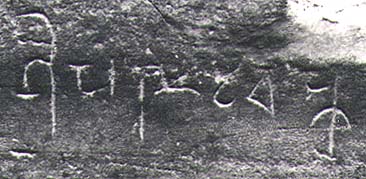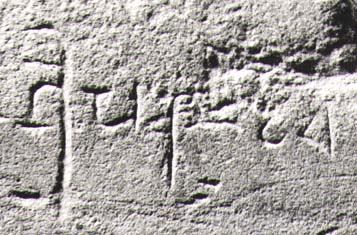Return to Jaya Varma
Inscription: Readings and details
 |
| 10. Inscription on the pedestal of the Jaya Varma- sculpture, length 42 cm. Photograph courtesy HMG Department of Archeology, photograph by Govind Ghimire. This photograph was taken before the sculpture was moved from the find spot, and thus shows it in the best possible condition and in a somewhat more readable state than it is at present. |
Inscription: Readings
Several scholars have produced facsimile reproductions of the inscription, which may be of some help in interpretation. We offer two below:
 |
| Reading of the inscription by Hemraj Sakya, Kathmandu Nepal |
 |
| Reading by Dinesh Chandra Regmi, Kathmandu, Nepal |
We suggest the following reading of the inscription:
sam*vata "a 7" (=107) s'ri- paramadevapka(4) maha-ra-jasya jaya va(r)m(m)a (x)
which we translate as:
In the year 107, the great king Jaya Varma-, the fourth (?) Great Lord.
Below we offer the various published readings of the inscription, followed by the source of the reading, including only those parts that differ from our reading. All scholars who have examined the inscription have agreed that the date is represented by the character "a" (symbolic of 100) followed by the numeral 7, thus 107.
paramadeva ... maha-ra-jesu jaya vamma
in "Licchavika-li-na abhilekhayukta mu-rti pra-pta", (Discovery of a sculpture with a Licchavi-period inscription, report from the Department of Archeology) Gorakha-patra, May 15, 1992 (VS 2049 Jeth 2) Friday, P.3 (News)
paramadeva pka maha-ra-j-a, sa jaya varmah*
by Hemraj Shakya as given in Tamot, Kashinath 1992. "Nigu-gu s'ata-bdiya- Licchavi juju jaya varma- mhasi-ke" (An Introduction to the second-century Licchavi king Jaya Varma), Ra-jamati, 10:29 (May 25), p. 5.
pan~cadevapka maha-ra-ja-sya jaya varmmana
in Shyam Sundar Rajbanshi's 'Pratikriya-' (letter to the editor), Gorkhapatra, May 25, 1992 (VS 2049 Jeth 12) Monday, p.2. In Rolamba, 14:3, July - Sept. 1994, "Sarva Pra-cina abhilekha ra-ja- jaya varma-ko abhilekha", p.11, Rajbanshi explains the "pan~cadevapka" of the inscription as referring to the bright half of the fifth lunar month, fourth day, that is Pha-lguna s'ukla caturthi-. However, we feel that the honorific s'ri- preceding this phrase is inappropriate for a date.
paramadev(anka) maha-ra-ja-s(ya) jaya varmma(nah*)
in Regmi, Dinesh Chandra 1992a. "Jayavarma- vam*sa-vali- ra pura-lekhana", Madhuparka, 25:5 / Sept.-Oct. 1992 (VS 2049 Asoj), pp. 42-46. Regmi considered the inscription to be Gupta period.
Mohan Prasad Khanal accepts the reading proposed by Rajbanshi, above, but explains the pan~cadeva and maha-ra-ja of his reading of the inscription as references to Kubera, Lord of the Yakshas, with pan~cadeva interpreted as a variant of pa-cika:
sam*vat a 7 (107) s'ri- pan~cadevapka maha-ra-jasya jayavarma
(Khanal, Mohan Prasad, Nepa-lko Kala-, Center for Nepal and Asian Studies, Tribhuvan University, Kathmandu, V.S. 2052 - 1995, pp. 261-268)
It can be seen that the main differences between the readings found above consist of the "paramadeva" of our reading being interpreted as "pan~cadeva" in the alternative. It is worth noting that our reading is supported by both of the facsimile reproductions shown above. To allow scholars familiar with this type of script to form an opinion, we hereby reproduce a closeup of the photograph of this part of the inscription. As we believe that the difference in the readings may stem from damage sustained by this portion of the sculpture subsequent to its discovery, we also reproduce a detail of this portion taken more recently:
 |
| Detail of the controversial characters, "s'ri- paramadevapka", from the photograph taken at the find spot; courtesy HMG Archeological Department, Nepal |
 |
| Detail of the controversial characters, "s'ri- paramadeva" (or "s'ri- pan~cadeva") from a later photograph showing the present condition. We believe it is damage to the inscription since the find that has led scholars to the "s'ri- pan~cadeva" reading. Photograph courtesy Thomas Schrom. For the full inscription please see below. |
 |
| Full inscription; photo taken recently. Photograph by Thomas Schrom |
Return to Jaya Varma





